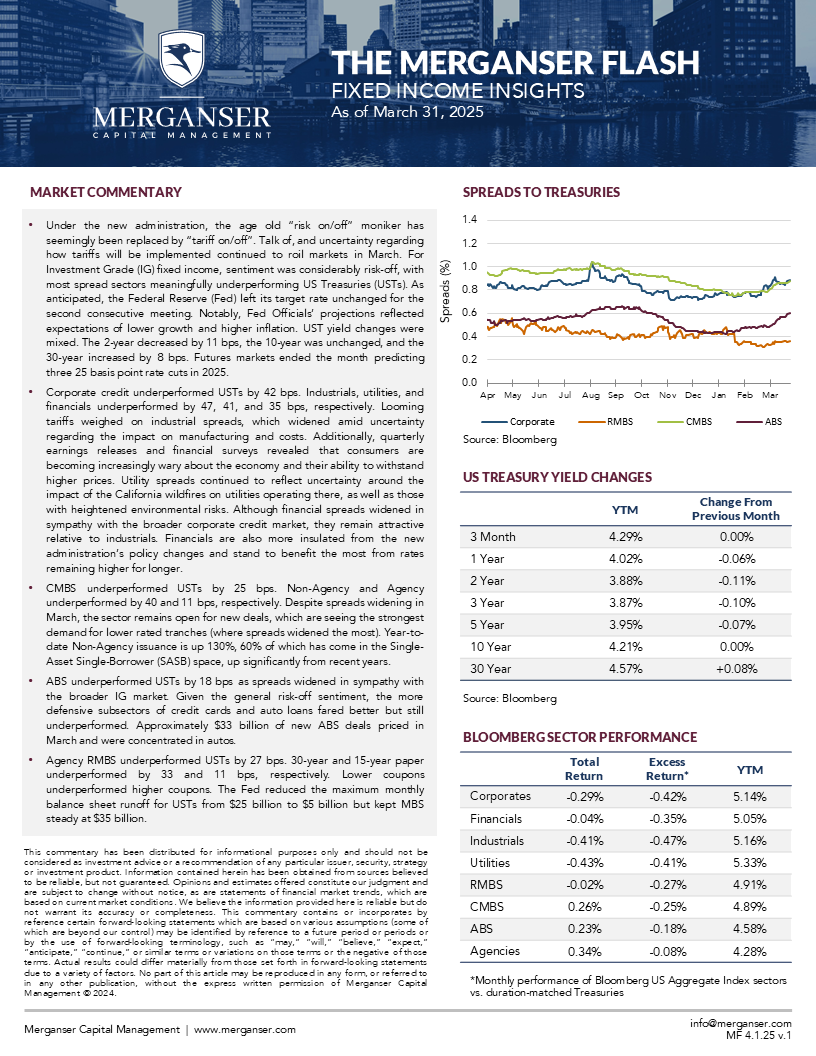- Under the new administration, the age old “risk on/off” moniker has seemingly been replaced by “tariff on/off”. Talk of, and uncertainty regarding how tariffs will be implemented continued to roil markets in March. For Investment Grade (IG) fixed income, sentiment was considerably risk-off, with most spread sectors meaningfully underperforming US Treasuries (USTs). As anticipated, the Federal Reserve (Fed) left its target rate unchanged for the second consecutive meeting. Notably, Fed Officials’ projections reflected expectations of lower growth and higher inflation. UST yield changes were mixed. The 2-year decreased by 11 bps, the 10-year was unchanged, and the 30-year increased by 8 bps. Futures markets ended the month predicting three 25 basis point rate cuts in 2025.
- Corporate credit underperformed USTs by 42 bps. Industrials, utilities, and financials underperformed by 47, 41, and 35 bps, respectively. Looming tariffs weighed on industrial spreads, which widened amid uncertainty regarding the impact on manufacturing and costs. Additionally, quarterly earnings releases and financial surveys revealed that consumers are becoming increasingly wary about the economy and their ability to withstand higher prices. Utility spreads continued to reflect uncertainty around the impact of the California wildfires on utilities operating there, as well as those with heightened environmental risks. Although financial spreads widened in sympathy with the broader corporate credit market, they remain attractive relative to industrials. Financials are also more insulated from the new administration’s policy changes and stand to benefit the most from rates remaining higher for longer.
- CMBS underperformed USTs by 25 bps. Non-Agency and Agency underperformed by 40 and 11 bps, respectively. Despite spreads widening in March, the sector remains open for new deals, which are seeing the strongest demand for lower rated tranches (where spreads widened the most). Year-to-date Non-Agency issuance is up 130%, 60% of which has come in the Single-Asset Single-Borrower (SASB) space, up significantly from recent years.
- ABS underperformed USTs by 18 bps as spreads widened in sympathy with the broader IG market. Given the general risk-off sentiment, the more defensive subsectors of credit cards and auto loans fared better but still underperformed. Approximately $33 billion of new ABS deals priced in March and were concentrated in autos.
- Agency RMBS underperformed USTs by 27 bps. 30-year and 15-year paper underperformed by 33 and 11 bps, respectively. Lower coupons underperformed higher coupons. The Fed reduced the maximum monthly balance sheet runoff for USTs from $25 billion to $5 billion but kept MBS steady at $35 billion.


